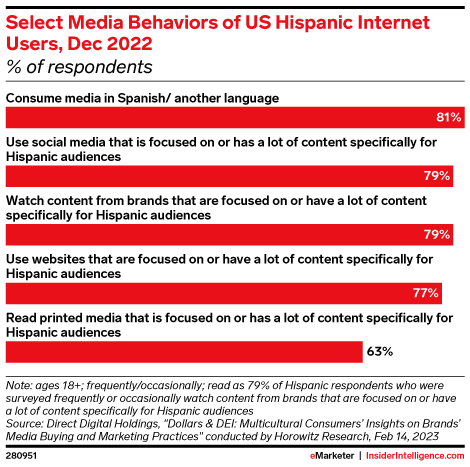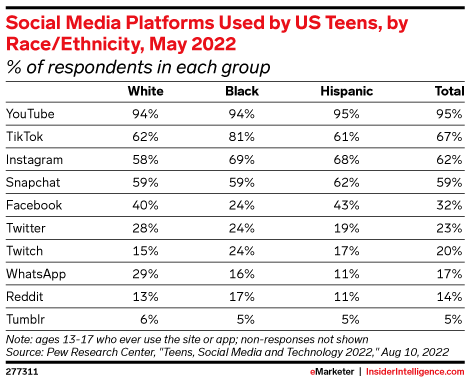Connecting with diverse audiences isn’t just good practice; it’s a necessity. At the front of the line for many brands are Hispanic consumers. This broad group has become a significant force in the US economy. They’re the second largest minority group in the US, contributing a remarkable $2.8 trillion, equivalent to 13% of the country’s GDP as of 2020, according to eMarketer.
It’s no surprise that brands want to connect with a group of consumers this large and influential. But marketers looking to reach Hispanic consumers can’t just copy and paste existing campaigns through a translator and expect to get results.
If you want to engage Hispanic consumers, you need to explore and implement strategies that leverage the right audience targeting, creative strategies, and media approaches for the specific groups you’re trying to reach and convert. Those won’t be static: Hispanic consumers are diverse and dynamic. You can’t approach them as a monolith.
Understand Hispanic audiences before creating your strategy
Before you can target this audience, you need to understand exactly who you’re looking for. The Hispanic audience is a complex tapestry woven from a rich blend of cultural backgrounds, languages, and different generations. In other words, Hispanic is not a race; its classification is based on language, country of origin, and cultural background. It also includes people of all races.
Because the Hispanic audience in the US encompasses a range of linguistic preferences, cultural ties, and generational nuances, marketers need to understand that there’s no “one-size-fits-all” solution.
Language shouldn’t be the default attribute to determine if an audience falls within the Hispanic segment. While some people are fully bilingual, others are more comfortable in English or Spanish, and some use the amalgamation of both known as Spanglish. Tools like language toggles can help brands capture language preferences and gain deeper insights into user behaviors.
Advertisers also have a tendency to take a broad approach to audience targeting instead of zeroing in on location. Although there are Hispanics across the 50 states and territories of the US, there are larger concentrations in specific states and designated market areas (DMAs) within those states that marketers should take into account.
Acknowledging these nuanced variations can empower advertisers to make informed decisions, tailoring their campaigns to resonate more profoundly with these target demographics and optimizing their messaging for maximum impact.
Use demographics and insights to find your target audience
To effectively identify and connect with your specific target Hispanic audience, you should start by understanding key demographics and psychographics that shape their preferences and behaviors.
To find your target audience, you should be asking the following questions about your data:
- Ethnicity: Do they identify as Hispanic (based on their country of origin or cultural heritage)?
- Language: Do they speak Spanish, English, or Spanglish?
- State/DMAs: Where do they live in the US?
- Age: Can their age bracket provide any insights about generational gaps?
Media vendors like Google, Meta, and others can provide additional data to enrich your audience insights. For a more nuanced understanding, leveraging site pixels and transactional data can reveal specific trends related to your brand or product. This granular data provides actionable insights that can inform targeted marketing strategies, like:
- Lifestyle
- Age
- Household income
- Product/service preferences

Source: eMarketer
When you’re crafting the ideal media mix, it’s also essential to recognize the media consumption patterns of Hispanic audiences. In general, they’re enthusiastic users of the internet and social media platforms, with a strong inclination toward video content consumption. Platforms like YouTube, TikTok, Instagram, and Snapchat hold significant sway among Hispanic audiences, offering prime opportunities for engagement.

Source: eMarketer
Streaming content is especially popular, particularly with millennials and younger demographics, who often opt for online streaming over traditional cable TV.
To build a comprehensive media mix, leverage different platforms and channels to reach different age groups, create content for specific platforms based on generational preference, and incorporate programmatic strategies for display and online video through contextual targeting.
Stick to best practices to avoid common Spanish ad targeting and creative mistakes
When developing your creative strategy, it’s important to steer clear of literal translations from your English language campaigns. Instead, be mindful of contextual nuances that hold significance for Hispanic consumers while staying true to your brand’s essence.
Take the example of McDonald’s iconic slogan “I’m lovin’ it.” A literal translation may have been “Me Gusta,” but the transcreation “Me Encanta” captures the slogan better. Both Spanish phrases mean roughly the same thing, but contextually they have different connotations. That matters for marketers trying to convey the McDonald’s brand identity.

Source: Ampere Translations
Cultural relevance should be the cornerstone of your creative approach; look to ideate, create, and deploy imagery, videos, and messaging that hold cultural significance while avoiding stereotypes and clichés like stock imagery that lacks authenticity or templated approaches that work for the general market.
Embrace ongoing testing, adaptation, and experimentation
This may come as a shock to marketers, but you can’t “solve” for Hispanic audience marketing. Rather than seeking a definitive formula and calling it quits, you need to consistently test new audiences and channels. This is especially true given the influx of new immigrants with varying needs and preferences.
Experimentation is critical for brands seeking to establish their niche within the Hispanic market. If you don’t know language preferences, try testing them all: Spanish, English, and Spanglish. Venture into unexplored niche platforms like Pinterest, gaming platforms like Twitch, or ads on platforms like Xbox to tap into new opportunities for engagement.
Successful engagement goes beyond language and reaches into the heart of culture, generational differences, and individual preferences.
The Hispanic audience is a dynamic and multifaceted demographic that demands a thoughtful and nuanced approach. By embracing authenticity, cultural resonance, and a commitment to continuous improvement, brands can forge lasting connections with the audience.
As the Hispanic demographic continues to evolve, your strategies should, too. By understanding and adapting to their unique attributes, brands can unlock the full potential of this vibrant and influential audience.
Learn how building diverse audiences impact your business long-term by downloading the on-demand webinar Culture, Community, and Conversion: How Connection Drives Business Growth.







Responses